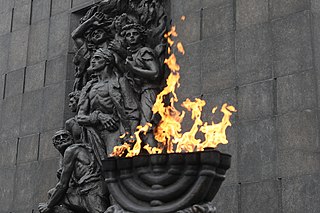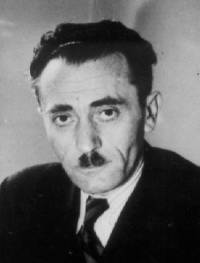
The Warsaw Ghetto was the largest of the Nazi ghettos during World War II and the Holocaust. It was established in November 1940 by the German authorities within the new General Government territory of occupied Poland. At its height, as many as 460,000 Jews were imprisoned there, in an area of 3.4 km2 (1.3 sq mi), with an average of 9.2 persons per room, barely subsisting on meager food rations. Jews were deported from the Warsaw Ghetto to Nazi concentration camps and mass-killing centers. In the summer of 1942, at least 254,000 ghetto residents were sent to the Treblinka extermination camp during Großaktion Warschau under the guise of "resettlement in the East" over the course of the summer. The ghetto was demolished by the Germans in May 1943 after the Warsaw Ghetto Uprising had temporarily halted the deportations. The total death toll among the prisoners of the ghetto is estimated to be at least 300,000 killed by bullet or gas, combined with 92,000 victims of starvation and related diseases, the Warsaw Ghetto Uprising, and the casualties of the final destruction of the ghetto.

A Judenrat was an administrative body established in German-occupied Europe during World War II which purported to represent a Jewish community in dealings with the Nazi authorities. The Germans required Jews to form Judenräte across the occupied territories at local and sometimes national levels.

Emanuel Ringelblum was a Polish historian, politician and social worker, known for his Notes from the Warsaw Ghetto, Notes on the Refugees in Zbąszyn chronicling the deportation of Jews from the town of Zbąszyń, and the so-called Ringelblum Archive of the Warsaw Ghetto.

The history of the Jews in Poland dates back at least 1,000 years. For centuries, Poland was home to the largest and most significant Ashkenazi Jewish community in the world. Poland was a principal center of Jewish culture, because of the long period of statutory religious tolerance and social autonomy which ended after the Partitions of Poland in the 18th century. During World War II there was a nearly complete genocidal destruction of the Polish Jewish community by Nazi Germany and its collaborators of various nationalities, during the German occupation of Poland between 1939 and 1945, called the Holocaust. Since the fall of communism in Poland, there has been a renewed interest in Jewish culture, featuring an annual Jewish Culture Festival, new study programs at Polish secondary schools and universities, and the opening of Warsaw's Museum of the History of Polish Jews.

Szmul Mordko Zygielbojm was a Polish socialist politician, Bund trade-union activist, and member of the National Council of the Polish government-in-exile.

Chaim Mordechaj Rumkowski was the head of the Jewish Council of Elders in the Łódź Ghetto appointed by Nazi Germany during the German occupation of Poland.

The Łódź Ghetto or Litzmannstadt Ghetto was a Nazi ghetto established by the German authorities for Polish Jews and Roma following the Invasion of Poland. It was the second-largest ghetto in all of German-occupied Europe after the Warsaw Ghetto. Situated in the city of Łódź, and originally intended as a preliminary step upon a more extensive plan of creating the Judenfrei province of Warthegau, the ghetto was transformed into a major industrial centre, manufacturing war supplies for Nazi Germany and especially for the Wehrmacht. The number of people incarcerated in it was increased further by the Jews deported from Nazi-controlled territories.

The Kraków Ghetto was one of five major metropolitan Nazi ghettos created by Germany in the new General Government territory during the German occupation of Poland in World War II. It was established for the purpose of exploitation, terror, and persecution of local Polish Jews. The ghetto was later used as a staging area for separating the "able workers" from those to be deported to extermination camps in Operation Reinhard. The ghetto was liquidated between June 1942 and March 1943, with most of its inhabitants deported to the Belzec extermination camp as well as to Płaszów slave-labor camp, and Auschwitz concentration camp, 60 kilometres (37 mi) rail distance.
Following the establishment of the Second Polish Republic after World War I and during the interwar period, the number of Jews in the country grew rapidly. According to the Polish national census of 1921, there were 2,845,364 Jews living in the Second Polish Republic; by late 1938 that number had grown by over 16 percent, to approximately 3,310,000, mainly through migration from Ukraine and the Soviet Russia. The average rate of permanent settlement was about 30,000 per annum. At the same time, every year around 100,000 Jews were passing through Poland in unofficial emigration overseas. Between the end of the Polish–Soviet War of 1919 and late 1938, the Jewish population of the Republic grew by nearly half a million, or over 464,000 persons. Jews preferred to live in the relatively-tolerant Poland rather than in the Soviet Union and continued to integrate, marry into Polish Gentile families, to bring them into their community through marriage, feel Polish and form an important part of Polish society. Between 1933 and 1938, around 25,000 German Jews fled Nazi Germany to sanctuary in Poland.

Beginning with the invasion of Poland during World War II, the Nazi regime set up ghettos across German-occupied Eastern Europe in order to segregate and confine Jews, and sometimes Romani people, into small sections of towns and cities furthering their exploitation. In German documents, and signage at ghetto entrances, the Nazis usually referred to them as Jüdischer Wohnbezirk or Wohngebiet der Juden, both of which translate as the Jewish Quarter. There were several distinct types including open ghettos, closed ghettos, work, transit, and destruction ghettos, as defined by the Holocaust historians. In a number of cases, they were the place of Jewish underground resistance against the German occupation, known collectively as the ghetto uprisings.

The Holocaust in Poland was the ghettoization, robbery, deportation and mass murder of Jews, alongside other groups under similar racial pretexts in occupied Poland by the Nazi Germany. 3,000,000+ Polish Jews were murdered, primarily at the Chelmno, Belzec, Sobibor, Treblinka and Auschwitz extermination camps, who made up half of the Jewish Holocaust victims.

The Jewish Police Service, commonly known as Jewish Ghetto Police, also called the Jewish Police by Jews, were auxiliary police units organized within the Nazi ghettos by local Judenrat.
Filip (Philip) Friedman was a Polish-Jewish historian and the author of several books on history and economics.
Lucjan Dobroszycki was a Polish scientist and historian specializing in modern Polish and Polish-Jewish history. A survivor of the Łódź Ghetto and Nazi concentration camps including Auschwitz, Dobroszycki lived in Poland after World War II where he obtained his education and worked as a historian. His main focus was the Nazi German occupation of Poland.

The Group 13 network was a Jewish collaborationist organization in the Warsaw Ghetto during the German occupation of Poland in World War II. The rise and fall of the Group was likely a proxy for power struggles between various factions in the German military and bureaucracy, for their own financial benefit.

The Piotrków Trybunalski Ghetto was created in Piotrków Trybunalski on October 8, 1939, shortly after the 1939 German Invasion of Poland in World War II. It was the first Nazi ghetto in occupied Europe. founded on October 8, 1939 The town was occupied by the Wehrmacht on September 5, 1939. Piotrków was made into a county seat (Kreis) of the newly created Łódź District of the German territory of Reichsgau Wartheland. The ghetto was put under the command of Hans Drexler, an appointed Nazi Oberbürgermeister who also created the ghetto. In total, some 16,500to up to 28,000 Jews went through the Piotrków Ghetto which was liquidated beginning 14 October 1942 in four days of deportations to Treblinka and Majdanek aboard overcrowded Holocaust trains.

Moshe (Mosheh) Merin was the head of the Jewish Community Council, or Judenrat, in the Sosnowiec Ghetto during the Nazi German occupation of Poland in World War II. It is believed that he was murdered in the Auschwitz concentration camp. As with most Jewish Council leadership of the time, his actions or lack thereof during the Holocaust in occupied Poland are highly controversial.

The Kraków Jewish Council was a 24-person Jewish managerial board formally established in the city of Kraków, Poland by German authorities in December 1939, and later in the Kraków Ghetto when the ghetto was officially formed on March 3, 1941. The Kraków Jewish Council formation was mandated by Nazi administration officials, who demanded that these councils be formed as supervisors of the inmates of their respective ghettos in the General Government, and in other occupied areas. The Jewish Council in Kraków was in direct contact and controlled by Nazi officials on most matters, but had some limited degree of autonomy. The Krakow Jewish council had 19 separate departments that oversaw labor, welfare, health and finance, among other items.
The Kraków Ghetto Jewish Police were a law enforcement service in the Kraków Ghetto, part of the system of the Jewish Ghetto Police. The OD were subordinated to the Judenrat of each ghetto. The Kraków OD, unlike many other Jewish Police forces, served as willing enforcers of Nazi policies and the Gestapo. Among other duties, they oversaw the liquidation of the Kraków Ghetto and helped transport Jews to Bełżec extermination camp.
Nachman Blumental was a Polish-Jewish and Israeli historian who served as the head of the Jewish Historical Institute in Warsaw between 1947 and 1949.















